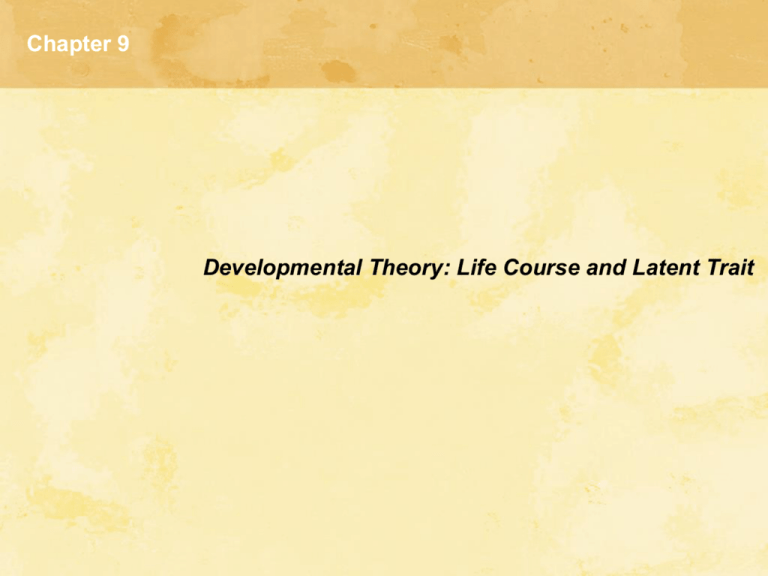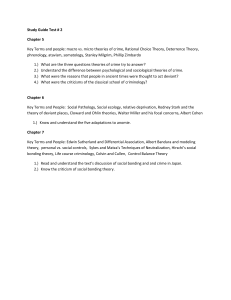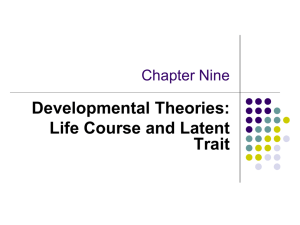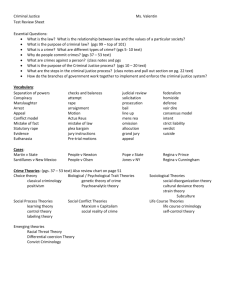Chapter 9 Developmental Theory
advertisement

Chapter 9 Developmental Theory: Life Course and Latent Trait Developmental Theories • Seek to identify, describe, and understand the development factors the explain the onset and continuation of a criminal career Intertwining of personal factors, social factors, socialization factors, cognitive factors, and situational factors Two distinct groups: life course theories and latent trait The Life Course View • Some people are incapable of maturing in a reasonable and timely fashion because of family, environmental and personal problems The propensity to commit crime is neither stable nor constant Life course theories at multidimensional, suggesting criminality has multiple roots Figure 9.1 Life Course and Latent Trait Theories The Life Course View • The Glueck Research Popularized the research on the life cycle of delinquent careers “The deeper the roots of childhood maladjustment, the smaller the change of adult adjustment” Family relations are paramount in terms of quality of discipline and emotional ties with parents Children with low IQ’s, a background of mental disease, and a powerful physique were most likely to be delinquent The Life Course View • Life Course Concepts Rolf Loeber and Marc LeBlanc devoted time to the evolution of the criminal career Attention should be given to how a criminal career unfolds People may show a propensity of offend early in their lives The Life Course View • Problem Behavior Syndrome Criminal behavior is one of many antisocial behaviors that cluster together and typically involve family dysfunction, sexual and physical abuse, substance abuse, smoking, and precocious sexuality. All varieties of criminal behavior may be part of a generalized PBS • Unemployment • Educational underachievement • School misconduct • Residing in high crime and disorganized areas • Exposure to racism and poverty • Personal problems such as suicide attempts, sensation seeking, early parenthood, accident-proneness, medical problems, mental disease, anxiety, and eating disorders The Life Course View • Pathways to Crime Loeber and associates identified three distinct pathways to a criminal career • Authority conflict: begins at an early age with stubborn behavior • Covert pathway: begins with minor underhanded behavior and leads to property damage • Overt pathway: escalates into aggressive acts and then to violence Figure 9.2 Loeber’s Pathways to Crime The Life Course View • Age of Onset/Continuity of Crime Life course theory suggests criminal careers are planted early in life May begin with truancy, cruelty to animals, lying, and theft Some offenders peak at an early age, whereas others persist into adulthood Continuity and desistance: Poor parental discipline and monitoring may be key to early criminality Rejection by peers and academic failure sustains antisocial behavior The Life Course View • Gender Similarities and Differences Like boys, early onset girls continue to experience difficulties such as drug/alcohol use, poor school adjustment, mental health problems, and a variety of relationship dysfunctions Early onset path for males results in problems at work and substance abuse Early onset pathways for females are more likely to lead to depression and a tendency to commit suicide The Life Course View • Adolescent Limiteds and Life Course Persisters Terrie Moffet suggests most offenders are adolescent limited in that antisocial behavior peaks and then diminishes A small group of offenders are persisters who begin offending at an early age and continue into adulthood Early starters experience: 1) poor parenting, 2) deviant behaviors and then 3) involvement with delinquent groups The Life Course View • Supporting Research Recent research supports Moffit’s views Early onset delinquents are influenced by individual traits such as low verbal ability, hyperactivity, and negative personality traits Community-level factors such as poverty and instability seem to have little effect on their behavior Theories of the Criminal Life Course • The Social Development Model Integration of social control, social learning, and structural theories (Weis, Catalano, Hawkins) Community-level risk factors contribute to criminality (social control, disorganization, and opportunities) Prosocial bonds may inhibit antisocial behaviors (attachment to conventional activities and beliefs) SDM-based interventions can help reduce delinquency and drug abuse Figure 9.3 The Social Development Model of Antisocial Behavior Theories of the Criminal Life Course • Farrington’s ICAP (Integrated Cognitive Antisocial Potential) Theory Farrington suggested traits present in persistent offenders can be observed at age 8 Future criminals receive poor parental supervision and harsh/erratic punishments Deviant behavior tends to be versatile rather than specialized Chronic offenders experience personal troubles and family dysfunction throughout their lives Marriage, employment, and relocation help to diminish criminal activity Theories of the Criminal Life Course • The IACP Theory David Farrington suggests antisocial potential (AP) falls along a continuum ranging form high to low AP Long-term AP: increases are contingent on desire for material goods, status, excitement, sexual satisfaction, and legitimate means for their attainment Short-term AP: is affected by situational inducements such as peers and criminal opportunities According to ICAP, the commission of offenses and antisocial acts depends on the interaction between an individual and the social environment People stop offending due to decreasing motivations, impulsiveness, decreasing physical capacities, and changes in socialization influences Figure 9.4 Farrington’s IACP Theory Theories of the Criminal Life Course • Interactional Theory Terence Thornberry proposed an age-graded view of crime The onset of crime can be traced to a deterioration of the social bond during adolescence Delinquent youths form belief systems consistent with their deviant lifestyles The causal process is dynamic and develops over a person’s life Figure 9.5 The Interactional Theory of Delinquency Theories of the Criminal Life Course • Testing Interactional Theory Research indicates that associating with delinquent peers does increase delinquent involvement Weakened attachments to family and the educational process appears to be related to delinquency Children who grow up in indigent households that experience unemployment, high mobility, and parental criminality are at risk Theories of the Criminal Life Course • General Theory of Crime and Delinquency Robert Agnew suggested environmental factors and social and physical traits contribute to criminality Crime occurs when constraints are low Five elements of human development: • Self: irritability and/or low self-control • Family: poor parenting or marriage problems • School: negative school experiences or limited education • Peers: Delinquent friends • Work: Unemployment or poor job Figure 9.6 Agnew’s General Theory of Crime and Delinquency Theories of the Criminal Life Course • Sampson and Laub: Age-Graded Theory Robert Sampson and John Laub identified “turning points” (critical events) that may enable an offender to desist from crime Career and marriage are turning points Social Capital: refers to positive relations with individuals and institutions, which support conventional behavior People who maintain a successful marriage and become parents are more likely to mature out of crime Figure 9.7 Sampson and Laub’s Age-Graded Thoery Theories of the Criminal Life Course • Testing Age-Graded Theory Indicators tend to support age-graded theory (i.e. employment) Research suggests the greater the social capital, the more likely one will be insulated from crime The Marriage Factor: People who marry and become parents are most likely mature out of crime Laub and Sampson are following up on the original research cohort of the Glueck’s Latent Trait View • Assumes some people have a personal attribute that controls their propensity to commit crime The trait is either present at birth or established early in life Propensity and opportunity to commit crime fluctuate over time Latent Trait View • Crime and Human Nature Wilson and Herrnstein’s human nature theory suggests genetics, intelligence, and body build contribute to criminality Biological and psychological traits influence crime choice and noncrime choices Their work suggests the existence of an elusive trait that predisposes people to commit crime Latent Trait Theories • General Theory of Crime (GTC) Michael Gottfredson and Travis Hirschi modified social control theory and integrated concepts of biosocial, psychological, routine activities, and rational choice theories GTC considers the offender and the criminal act as separate concepts People commit crime when it promises rewards and they are predisposed to commit crime Tendencies to commit crime is contingent on a person’s level of self-control Root of poor self-control is traced to inadequate child-rearing practices Gottfredson and Hirschi maintain the GTC explains all varieties of criminal behavior Empirical evidence tends to support the GTC Figure 9.8 Gottfredson and Hirschi’s General Theory of Crime Latent Trait Theories • Analyzing the General Theory of Crime Some critics charge GTC is: Tautological: Crime and impulsive behavior Different Classes of Criminals: Research indicates offenders occupy more than one class and more than one factor may contribute to their criminality Ecological/Individual Differences: Fails to address individual and ecological patterns in crime rates Racial and Gender Differences: Little evidence that males are more impulsive than females and overlooks racism and poverty issues Moral Beliefs: GTC ignores the moral concept of right and wrong Peer Influence: Negative influences of peers increases the likelihood of criminality rather than reducing it People Change: Propensity to commit crime does change and it is not static as suggested by GTC Modest Relationship: Self control is modestly related to antisocial behavior Cross Cultural Differences: GTC may be weak in cross-national studies Misreads Human Nature: GTC assumes people are selfish, self-serving, and hedonistic Personality Disorder: GTC ignores personality disorders Latent Trait Theories • Differential Coercion Theory Mark Colvin suggests coercion as a master trait for criminality Interpersonal Coercion: involves the use or threat of force and intimidation from parents, peers, and others Impersonal Coercion: involves pressures such as economic and social pressures (poverty-competition) Maintaining self control is contingent on the function, type and consistency of coercion To reduce crime society must enhance legitimate social support and reduce the forces of coercion Figure 9.9 Colvin’s Theory of Differential Coercion Latent Trait Theories • Coercion and Criminal Careers Chronic offenders grow up in homes with erratic and inconsistent control Coercive Ideation: the world is conceived as full of coercive forces that need equal or greater coercive responses to overcome Differential Social Support: Social support may negate or counterbalance crime-producing coercion • Expressive social support (affirmation of self-worth) • Instrumental social support (financial assistance) Latent Trait Theories • Control Balance Theory Charles Tittle suggest control has two elements that when out of balance produce deviant and criminal behaviors • The amount of control one is subject to by others • The amount of control one can exercise over others Three types of behavior restores balance for those who sense a deficit: • Predation: direct forms of physical violence • Defiance: challenges to control mechanisms • Submission: passive obedience Those with an excess of control engage in: • Exploitation: using others to commit crime • Plunder: using power without regard for others • Decadence: spur of the moment irrational acts Figure 9.10 Tittle’s Control Balance Theory Latent Trait Theories • Evaluating Developmental Theories Life course theorists emphasize the influence of changing interpersonal and structural factors Latent trait theorists place more emphasis on behavior being linked to personal change than to changes in the surrounding world CNN Clip - Drug Cartel Leader On Trial Public Policy Implications of Developmental Theory Multi-systematic treatment efforts Programs targeting those at high risk to improve their developmental skills SMART (skills, mastery, and resistance training)








